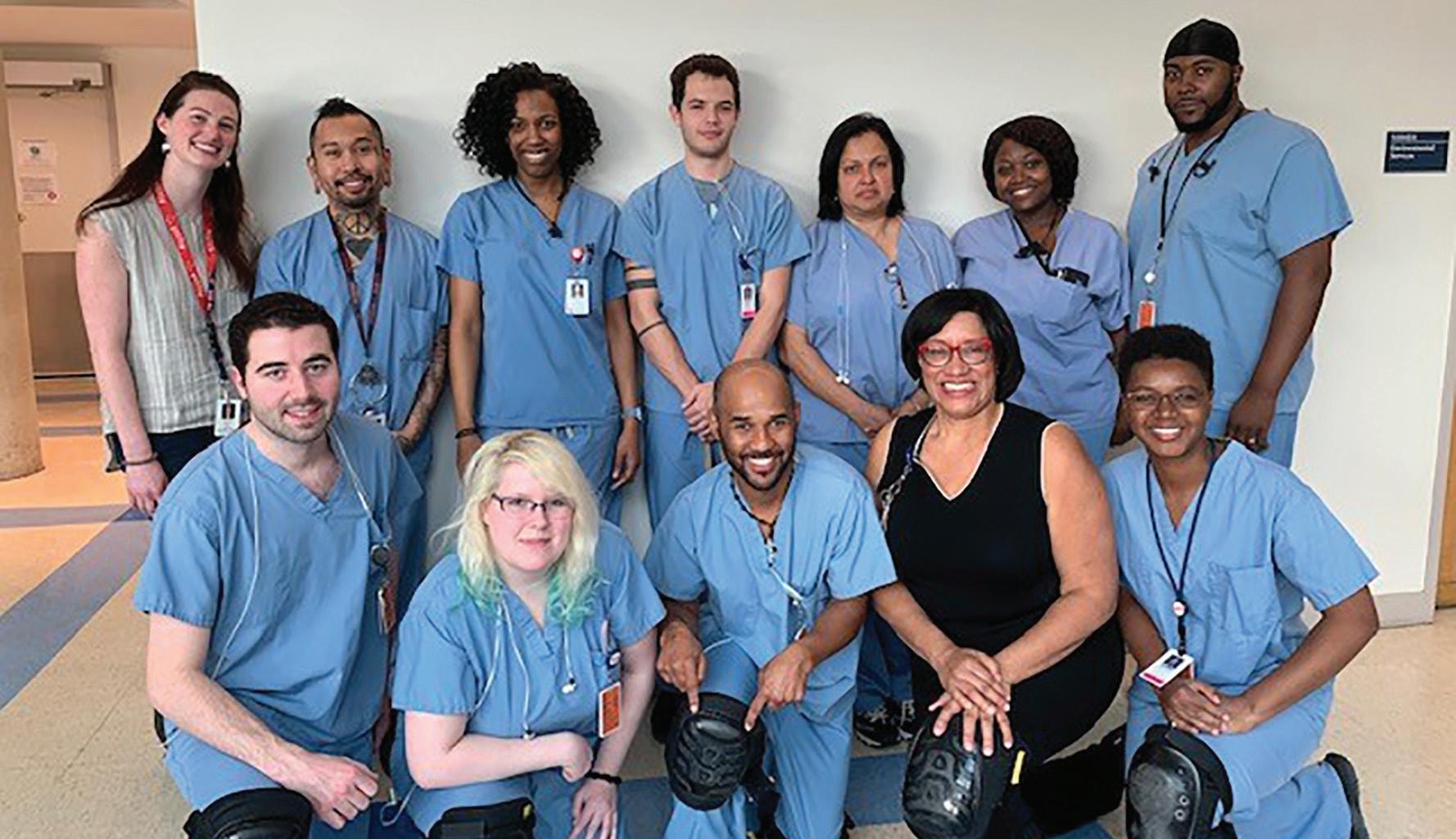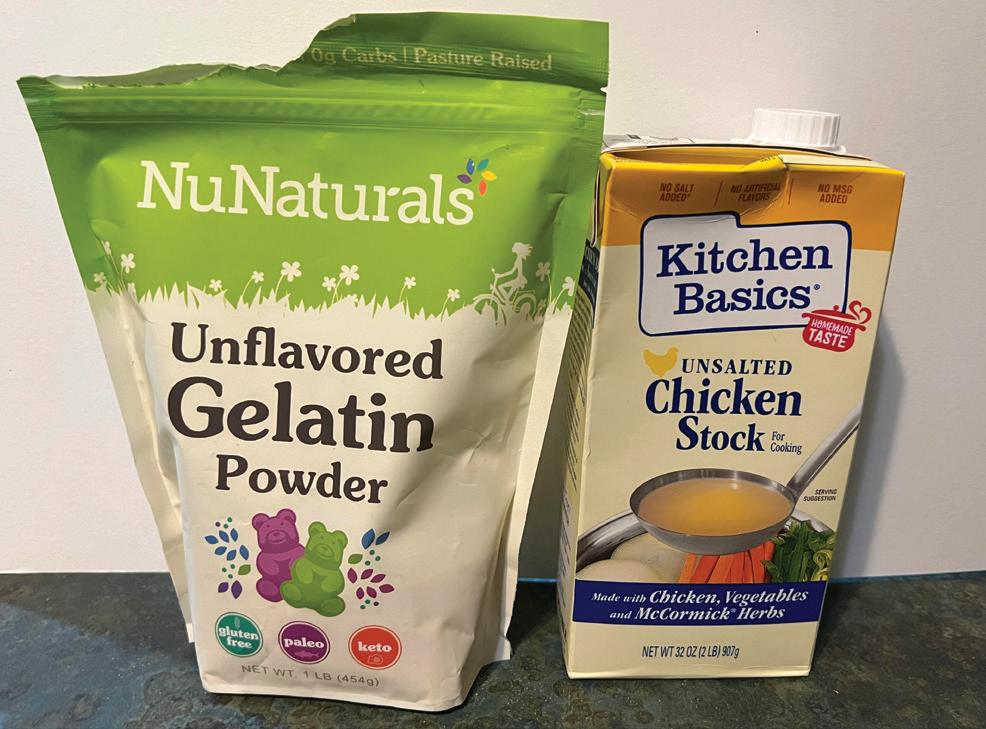
12 minute read
Tech Tips
by aalasoffice
Sterility of Glass Micropipettes Used in Rodent Stereotactic Surgery
By: Monika Huss, DVM, MS, DACLAM, Paul Yuan, PhD, Roberta Moorhead, and Megan A. Albertelli, DVM, PhD, DACLAM
Invasive surgical procedures involve contact with a surgical instrument to a patient’s sterile tissue. A risk during surgical procedures is the introduction of pathogenic microbes through non-sterile instruments which can lead to infection.4 Micropipettes are commonly used in rodent stereotactic surgery for injection of viral vectors2 or gene delivery.1 They are made to a small tip diameter varying from 0.1-100 µm. Research scientists create micropipettes by stretching glass pipettes over a flame or for additional precision and smaller diameter pipette, a commercial pipette puller can be used. Frequently in-house made pipettes are stored until the time of use inside of a Petri dish on modeling clay.
Pre-pulled borosilicate glass micropipettes are also available for purchase from commercial vendors; however, these micropipettes do not come packaged sterilely. Commonly used sterilization techniques such as autoclaving or using a hot bead sterilizer are not used for sterilization of micropipettes because of concern for maintaining the integrity of the micropipette tip. The sterility and suitability of in-house made micropipettes or ability to autoclave for later use for sterile survival surgical procedures is unknown. In this study we sought to evaluate the sterility of micropipette tips after pulling them in house, as well as determine if it is possible to autoclave micropipettes and maintain their integrity.
Micropipette Creation and Sampling Methods
We secured the glass filaments used to make the micropipettes from Sutter Instrument Company (Novato, CA, item # BF-10058-10). We evaluated 45 micropipettes pulled on a commercial Microelectrode Puller (World Precision Instruments, Sarasota, FL) in 5 experimental groups: 1) non-autoclaved immediate sampling, 2) non-autoclaved 1-hour sampling, 3) non-autoclaved 1-day sampling, 4) non-autoclaved 2-day sampling, and 5) autoclaved immediate sampling. Upon pulling, non-autoclaved micropipettes were placed inside sterile 10 cm petri dishes (Nest, San Diego, CA) resting the body of the micropipette on a strip (6 cm x 2 cm x 2cm) of Permoplast Modeling Clay (Amaco, Indianapolis, IN) (See Figure 1). For autoclaving, micropipettes were placed inside of 10-cm glass petri dishes (Sigma Aldrich, St. Louis, MO) on Permoplast Modeling Clay with a chemical indicator strip (McKesson, Richmond, VA) and then wrapped with steam indicator tape (3M ComplyTM, St. Paul, MN). Petri dishes were stacked in a metal petri dish holder inside of a rat cage (See Figure 2) and then autoclaved inside of a steam autoclave at 127°C for 20 minutes. Sterilization effectiveness was verified by chemical indicator strips and autoclave tape.
To evaluate the sterility of the micropipette tips of the different groups, the distal 1-cm of the micropipette tip was sampled in a sterile TSB broth container. For each experimental group, one TSB broth container was also opened and closed to use as a negative control. Antimicrobial efficacy was assessed quantitatively by culturing surface bacteria plated onto Tryptic Soy Agar with 5% Sheep Blood plates (15 X 100mm monoplate, Hardy Diagnostics). Isolates were incubated at 35 °C in 5% CO2 for up to 5 days.
Somno
Low-fl ow electronic vaporizers
kentscientifi c.com/somnofl o

Figure 1. Non-autoclaved micropipettes are rested immediately after making them on Thermoplast modeling clay inside of a sterile Petri Dish.



Figure 2. Autoclaved micropipette were placed inside of a metal Petri Dish holder inside of a rat cage and autoclaved
Plates were subsequently observed for bacterial growth and basic morphological characteristics, such as colony pigmentation, size, and texture. Gram stains were performed to study microscopic morphology. After an incubation period of 18–24 h, any bacterial growth was identified using Biolog OmniLog Identification System [Biolog (Biolog, Hayward, CA].
Sterility Results
Immediate sampling of non-autoclaved micropipette tips indicated that there were no bacterial colony forming units. For the non-autoclaved micropipette tips sampled at 1-hour after making, 1 of 9 micropipettes sampled formed 1 colony units of Paenibacillus timonensis. In the non-autoclaved micropipettes groups at the 1-day and 2-day timepoint, none of the micropipette tips sampled formed colony forming units. Immediate sampling of the autoclaved micropipette tips indicated that no growth on any of the micropipettes sampled. All control containers for the experimental groups were negative for bacterial growth. Micropipette tip integrity and functionality was confirmed by a research scientist (P.Y.) performing intracranial injections. We are suspicious that the contamination of 1/9 of the micropipettes sampled 1-hour after pulling may have occurred during closure of the lid during the storage process or during micropipette sampling. Paenibacillus are gram-positive bacilli endospore forming aerobic or facultatively anaerobic bacteria that are isolated from environmental sources including water, soil, food and plants are typically not associated with infection.3 There is one case report of Paenibacillus timonenesis causing a skin infection in a 37-year-old man3 but it otherwise has not been described as a cause of surgical wound contamination in humans or veterinary patients.
From these results, we believe that micropipette tips can be used without additional sterilization for stereotactic procedures if they are maintained in a sterile container for 2-days after pulling them with a commercial puller or over a flame. We also determined that it is possible to autoclave the micropipettes for sterilization by placing the micropipettes on modeling clay, in glass petri dishes and inside of a protective container during the autoclave process.
Monika Huss, DVM, MS, DACLAM, is a Clinical Assistant Professor in the Department of Comparative Medicine at Stanford University in Stanford, CA. Paul Yuan, PhD, is an Assistant Professor at the Institute for Translational Brain Research at Fudan University in Shanghai, China. Roberta Moorhead is the Lab Manager of the Animal Diagnostic Laboratory in the Veterinary Service Center at Stanford University in Stanford, CA. Megan Albertelli, DVM, PhD, DACLAM, is an Associate Professor in the Department of Comparative Medicine at Stanford University in Stanford, CA.
REFERENCES 1. Cetin A, Komai S, Eliava M, Seeburg PH, Osten P. 2007. Stereotaxic gene delivery in the rodent brain. Nat Protoc 1:3166. 2. Correia PA, Matias S, Mainen ZF. 2017. Stereotaxic adeno-associated virus injection and cannula implantation in the dorsal raphe nucleus of mice. Bio Protoc 7:2549.
3. de Salazar A, Ferrer F, Vinuesa D, Chueca N, Luis-Perez C,
Garcia F. 2020. Unusual case report of skin infection by Paenibacillus timonensis. Revista Española de Quimioterapia 33. 4. Rutala WA, Weber DJ. 2013. Disinfection and sterilization: An overview. Am Journ of Infect Cont 41:S2-S5.
Features & Benefits of Low-Flow:
• • Flow rates as low as 50mL/min
Saves money by using less than 1 mL/hr of isofl urane Saves money by using less than 1 mL/hr of isofl urane • Built-in air compressor
Uses ambient air or compressed gas Uses ambient air or compressed gas • No servicing or calibration needed
Cost-e ective, reliable equipment Cost-e ective, reliable equipment



Effects of Hair Removal Creams on Mouse Skin
By Michelle Reichert, BVetMed MRCVS, Nathan Koewler, DVM, DACLAM, Ann M. Hargis, DVM MS, DACVP, and Lynn Collura Impelluso, DVM, MBA,
DACLAM
Removing animal hair prior to a procedure is a common requirement to minimize contamination and improve visualization. Human hair removal brands such as Nair™ (Church & Dwight; Ewing, NJ) are sometimes used in research to remove hair from mice before surgery, imaging, and other procedures.1,3 While the use of these depilatory creams in rodent research is relatively widespread, few studies have evaluated their potential to cause tissue injury despite the fact that they contain active ingredients that are known irritants and corrosives.4
A significant concern with depilatory creams in rodents is that their instructions regarding contact time are for usage on human hair. While Nair™ recommends leaving creams on for 3-5 minutes for human use, contact times found in the literature for rodents range from 5 seconds to 10 minutes,1, 5, 2 with 73% of respondents of a recent survey reporting using contact times of 30 seconds to 120 seconds.3 A previous study using body formula Nair™ in rodents for 10 seconds found markers of inflammation, including epidermal hyperplasia, dermal fibroplasia, and infiltration of neutrophils.2 Another study using Nair™ for 15-20 seconds found epidermal hyperplasia and increased dermal immune cells compared to just shaving.1 Both of these rodent studies used relatively short contact times compared to the reported average of 30-120 seconds,3 suggesting that most application protocols may be inducing significant inflammatory changes.
We sought to determine how the contact time of Nair™ affects mouse skin to understand better the effects of these creams on animal welfare and research outcomes. We also hope to use this data to provide recommendations for Nair™ contact times to the researchers who use it as a means of hair removal.
Materials and Methods
Two strains of mice (C57BL/6, n = 32 and Crl:CD-1(ICR), n = 32) were used in the study to compare the effects of Nair™ cream on both pigmented and albino skin. Mice had body formula Nair™ applied to one flank for 15, 30, 60, or 120 seconds whereas the contralateral flank was shaved with clippers (WAHL Professional BravMini; Sterling, IL) to serve as a control (Figure 1). Skin samples were collected for histologic evaluation 3 days after Nair™ application (this collection time point was determined to be the point of peak inflammation after Nair™ application during a previous pilot study). All experimental procedures were approved by the IACUC at the University of Minnesota.
Skin samples were analyzed by a veterinary pathologist using the scoring system shown in Table 1. The criteria assessed are well-known markers of cutaneous inflammation and proliferation2,3 and the pathologist was blinded to treatment groups. All data were analyzed via nonparametric comparisons using Wilcoxon Method, with P ≤ 0.05 being significant.

Figure 1: Example diagram of control skin (flanks) (A; shaved with clippers) versus treatment (B; application of Nair). Treatment and control flanks were assigned randomly.
Results and Conclusions
In C57BL/6 mice, Nair™ caused an increase in the average histopathologic score at each contact time evaluated compared to skin that had been shaved (Figure 2). However, this increase was statistically significant for contact times of 30 or 60 seconds. The lack of significance seen at 15 and 120 seconds of contact time may be due to the loss of several samples from these groups during the transport of the skin samples; thus, these groups included fewer animals. Conversely, in CD-1 mice, Nair™ caused a statically significant increase in the average histopathologic score at every contact time evaluated (Figure 3).
These results support our hypothesis that the use of
Figure 2: The effect of Nair contact time on the average histopathologic skin scores in C57/BL6 mice (n = 6 - 8 per contact time). Shaving the contralateral flank of each animal was used as a control. *Significant differences between the Nair treated skin and control (shaved) skin. Data are means ± SEM. Figure 3: The effect of Nair contact time on the average histopathologic skin scores in CD-1 mice (n = 7 - 8 per contact time). Shaving the contralateral flank of each animal was used as a control. *Significant differences between the Nair treated skin and control (shaved) skin. Data are means ± SEM.

Nair™ cream on mouse skin is not innocuous but causes pathological changes associated with inflammation and proliferation. Our results also highlight how these pathological changes are not consistent across all of Mus musculus. Although not statistically significant, overall, the histopathologic scores were higher in CD-1 mice when compared to C57BL/6 mice. This may be due to a feature within C57BL/6 mice skin having a protective effect against Nair™ or could be due to an intrinsic quality of CD-1 mice causing increased sensitivity to the cream.
Unexpectedly, there was no correlation between contact time and total histopathologic score. There was no significant difference between any of the contact times evaluated for both strains. These results suggest that Nair™ induces tissue injury regardless of how long it is in contact with the skin; therefore, the use of Nair™ on mouse skin for any length of time is not innocuous.
As there was no effect of contact time on tissue injury, there is no current recommendation for how long to leave these creams on the skin to minimize injury. If depilatory creams are to be used, the authors strongly advise careful and thorough removal of the cream using a 2-step method: first gently removing the cream with a damp piece of gauze, then gently drying the area with dry gauze. This process is recommended as we noted that the cream could be challenging to remove, therefore creating the potential for residual cream to continue to damage the skin until it is removed by grooming or wear. We recommend researchers consult with their institutional veterinarians to discuss the potential research complications of using Nair™ cream instead of clippers before a mouse procedure.
The results from this article will be combined with additional clinical skin scores (erythema, ulceration, and edema) and depilation scores. These additional data will help determine if certain contact times result in noticeable clinical changes such as erythema, edema, or ulceration. Depilation scores (i.e., how much hair is removed) will provide a way of validating if the contact times evaluated are sufficient to achieve a degree of hair removal that is comparable to using clippers.

Michelle Reichert, BVetMed MRCVS, is a third-year laboratory animal medicine resident at the University of Minnesota in Minneapolis, Minnesota. Lynn C Impelluso, DVM, MBA, DACLAM, is the Director of Research Animal Resources and Attending Veterinarian at the University of Minnesota in Minneapolis, Minnesota. Nathan Koewler, DVM, DACLAM, is the Assistant Director of Veterinary Services for Research Animal Resources at the University of Minnesota in Minneapolis, Minnesota. Ann M. Hargis, DVM, MS, DACVP, is the owner of DermatoDiagnostics, in Edmonds, WA.
REFERENCES
1. Amberg N, Holcmann M, Stulnig G, Glitzner E, Sibilia M.
2017. Effects of depilation methods on imiquimod-induced skin inflammation in mice. J Investig Dermatol 137: 528-531. 2. Kick BL, Gumber S, Wang H, Moore RH, Taylor DK. Evaluation of 4 presurgical skin preparation methods in mice. J Am Assoc Lab Anim Sci 58: 71-77.
3. Liepert LD, Raphel J, Smith VL, Reilly N, Khan S, Dethlefs
C, Chapman S, Adusumilli S, Leevy WM. 2019. 3D-printed wash station with integrated anesthesia delivery manifold for high-throughput depilation of laboratory mice. J Am Assoc Lab Anim Sci 58: 65-70. 4. U.S. National Library of Medicine. [Internet] 2022. PubChem compound summary: Sodium hydroxide. [Cited 19 Jan 2022]. Available at: pubchem.ncbi.nlm.nih.gov 5. Woodcock A, Magnus IA. 1976. The sunburn cell in mouse skin: preliminary quantitative studies on its production. Brit J Derm 95: 459-468.








